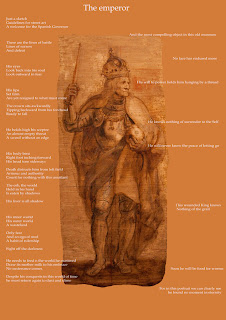http://www.ashmoleanprints.com/image/383266/italian-padua-inkstand-pan-listening-to-echo
Name of poet:
DIANA MOORE
date sent in: 3rd June
2013
Title of poem: PAN
AND HIS PIPES
Name of object in the museum: PAN LISTENING TO ECHO
Number and name of Gallery in the museum: WESTERN ART, GALLERY 43
Pan and his pipes. Pan and his pipes . Pipes, pipes, pipes.
Pan and his pipes. Pan and his pipes. Pipes, pipes, pipes.
He’s stopped and he’s
stopped in his tracks. Tracks.
What is it in the air
that he lacks? Lacks, lacks.
I have waited in the
meadow with the flowers. Hours
Sweet are the daisy
and cowslip. Slip
Here in the meadow, alone
by and by
I sigh. Sigh.
Where are you Echo my
love? I Love.
You are my only love.
Am I your only one? Only one.
Here am I for you
always, to no other will I go. Go.
Is that you singing
in the leaves, don’t leave me. Leave me.
Alone, I don’t want
to be alone. Alone.
What say you plants…?
Come Crested dogs-tail. I ail.
Do you feel low, as I
do, Musk mallow?
Are you ill for love,
Tormentil?
Here among the Meadow Brome. I roam
I roam and seek your
presence. Essence.
I have waited in the
meadowsweet meadow. Oh!
Echo, come take my
hand. And
I will wait for you
here in the meadow. Oh! Woe!
©Diana Moore
~~~~~~~~~~~~~~~~~~~~~~~~~~~~~~~~~~~~~~~~~~~~~~~~~~~~~~~~~~~~~~~~~~~~~~~~~~~~~~~~~
Diana writes and performs for
both children and adults. Her poetry
workshops are fun and interactive. For
further information, or to book an event, please contact Diana via her website
or on mobile: 07789 302995.
www.diana-moore.com
Information sourced
from the Ashmolean research team.
Pan Listening to Echo
Attributed to DESIDERIO DA
FIRENZE
(active Veneto 1532 – 45)
Padua or Venice, 1520 - 30
Long regarded as one of the most
poetic small bronzes of the Italian Renaissance, the so-called Pan listening to Echo was the first
bronze that Fortnum ever acquired.
The classical god of the woods
and fields is here shown in near-human form, with only his small horns, sharp
pointed ears and tuft of tail betraying his true nature. More commonly depicted in art as a satyr-like
figure driven by his animal instincts, Pan is depicted in quite a different
light in the story of his vain love for the nymph Echo, which appears in Greek
pastoral poetry. Around the beginning of
the sixteenth century, the story enjoyed renewed popularity because of the
enormous success of the poem Pan and Echo
by the great poet Poliziano, first published in 1494. These haunting verses, in which the echo
responds to the lover’s lament, are a perfect gloss on the bronze and may well
have directly inspired it.
Che fai tu Echo mentre chio ti
chiamo? Amo.
Ami tu duo/ o pur un solo? un
solo.
E io te sol e non altri amo:
altri amo
Dunque non ami tu un solo? Un
solo
Questo è un dirmi inon tamo:
inon tamo
Quel che tu ami: amil tu solo?
Solo
Chi tha levato dal mio Amore?
Amore
Chef a quello achi porti Amore?
Ah more.
Note: The above is
an extract from a longer (two-page) article.
Inspiration for the
piece ~ a note from Diana Moore
I was taken with gentleness of Pan in this bronze, as well
as the title Pan Listening to Echo. I
was curious as to why he is depicted in this almost human form (he has toes,
while the satyr-like Pan god has cloven hooves). I like the detail and quality (you need to
see his back for the muscle detail). I
could see scope to write a musical piece, however, for this occasion, I have
experimented with an echo poem. I met
with a native Italian to get a translation of the old poem (above) and this
gave me a starting point for my own work.
Greek Mythology
There are a number of stories of Echo in Greek
mythology. Firstly, Echo had her power
of speech taken away by Zeus’s wife, Hera
(see the tale of Echo and Hera);
secondly, Echo fell in love with
Narcissus, but Narcissus was only in love with himself. Thirdly, Pan fell in love with Echo but Echo
did not love him back and that is the angle I have chosen to write about, Pan’s
vain love for Echo.
There is a more harrowing tale of Pan and Echo in which she
is torn to shreds for rejecting Pan, and there is yet another story that
suggests Pan and Echo were married and had two children…!














.jpg)


